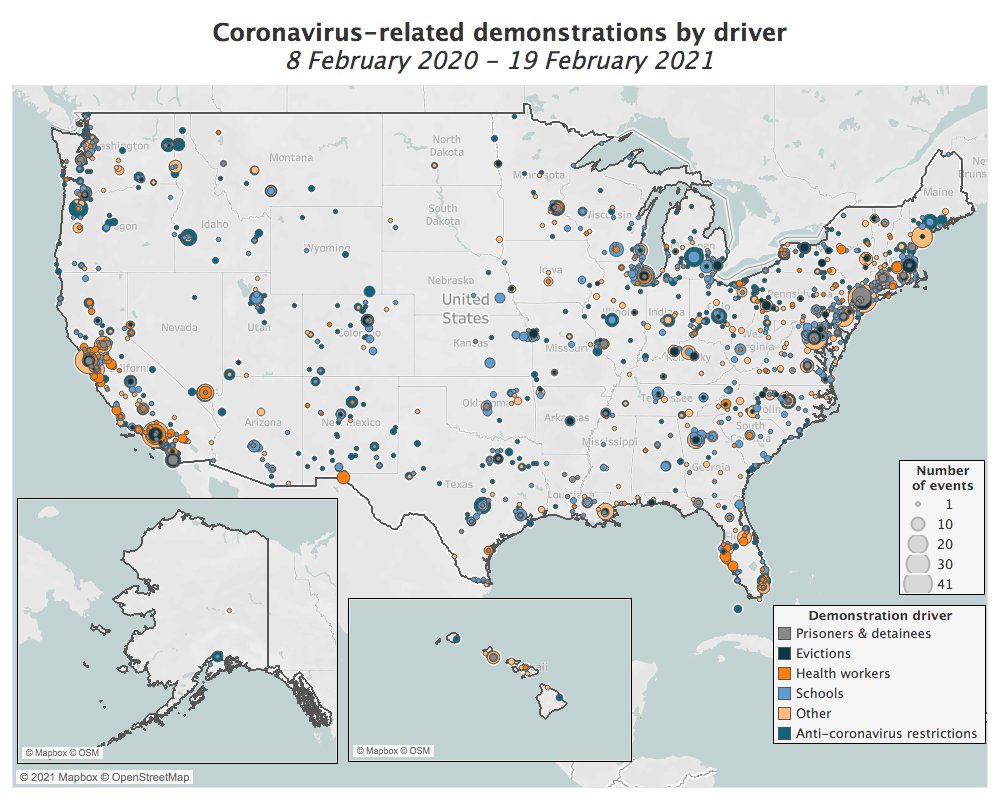
NEW | A National Emergency: How #COVID19 Is Fueling Unrest in the #US
Analyzing the past year of @ACLEDINFO data, our latest report reveals the full scope of the pandemic’s impact on #American protest patterns for the first time.
Key findings ▶️ bit.ly/3rkNZGR


Analyzing the past year of @ACLEDINFO data, our latest report reveals the full scope of the pandemic’s impact on #American protest patterns for the first time.
Key findings ▶️ bit.ly/3rkNZGR



Trends in pandemic-related demonstrations are closely correlated with trends in #COVID19 cases, with spikes in unrest matching infection waves reported throughout 2020. 

ACLED data show that the majority of these demonstrations have been organized around five main drivers: the risks faced by health workers, the safety of prisoners and ICE detainees, anti-restriction mobilization, the eviction crisis, and school closures. 

#HealthWorkers have protested to call for safer working conditions and a stronger government response to the pandemic. Demonstrations organized by health workers have contributed to protest spikes throughout the year, with events reported in at least 38 states and DC. 



Demonstrations by and in solidarity with #prisoners and ICE detainees — who are at particularly high risk of infection — have been organized in at least 37 states and DC. In more than a third of all peaceful protests held by prisoners and detainees, guards have used force. 

#Lockdowns to curb the spread of the virus have prompted thousands of anti-restriction demonstrations, with events reported in every state and DC. Over 23% of all demonstrations involving militarized right-wing groups like militias have been organized in opposition to lockdowns. 



Anti-restriction demonstrations involving these groups have turned violent or destructive over 55% of the time, relative to less than 4% of the time when they are not present, underscoring the destabilizing role militias can play in right-wing mobilization. 

Demonstrations over the #eviction crisis triggered by the pandemic have fluctuated in response to federal and state relief packages as well as measures to postpone or ban evictions. These demonstrations have taken place in at least 35 states and DC. 

The battle around #SchoolReopening has led to waves of protests both for and against a return to in-person teaching. Approximately two-fifths of these demonstrations have been opposed to reopening, while about three-fifths have been in favor. 

Both movements have been widespread geographically, with 43 states and DC hosting demonstrations against reopening and all but Arkansas and DC hosting demonstrations in support of reopening. 

A year on, the health crisis has exacerbated existing inequalities and political faultlines in the #US, contributing to a surge in unrest. The data suggest that these trends will continue to evolve amid the ongoing #vaccine rollout.
acleddata.com/2021/03/04/a-n…
acleddata.com/2021/03/04/a-n…
• • •
Missing some Tweet in this thread? You can try to
force a refresh


